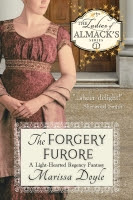Writers, particularly historical writers, tend to have long
bucket lists of things they hope to do one day.
High on mine is visiting a number of sites in England, and I think I've
just added another: Ditton Manor.
Nestled among quiet villages near Windsor Castle, the
200-acre estate dates back more than 1,000 years, though the current house is
just shy of 200 years old. Though the
house itself is called Ditton Manor and was built in the Gothic Revival style,
it resembles nothing so much as a castle, complete with turrets and its own
moat. In the early nineteenth century, you would
have driven in your carriage along a circle of elms leading to an elegant
iron-railed bridge over the east arm of the moat to pass through the crenelated
gatehouse into a walled forecourt. Entering the house, you would have looked up
at the Gothic cast-iron balustrade of the balcony that encircled the first
floor. The formal gardens outside even
included a maze.
 What surprised me most about Ditton Manor’s history, however,
was the number of woman who loomed large in an era when estates generally
passed from father to son. Queen Mary I
played here when she was a girl accompanied by her father King Henry VIII. In 1709 John, Duke of Montagu, inherited the
place, but he died leaving no male heirs.
Instead, his daughter Mary inherited the house. She also had no
surviving male heirs, so the house transferred to her daughter Elizabeth.
What surprised me most about Ditton Manor’s history, however,
was the number of woman who loomed large in an era when estates generally
passed from father to son. Queen Mary I
played here when she was a girl accompanied by her father King Henry VIII. In 1709 John, Duke of Montagu, inherited the
place, but he died leaving no male heirs.
Instead, his daughter Mary inherited the house. She also had no
surviving male heirs, so the house transferred to her daughter Elizabeth.
Elizabeth was a dowager, friend to Queen Caroline, in April
1812, when the original house burned down. Thankfully, no one was hurt, and
many of the fine pieces inside the house were saved. Legend has it King George
III traveled from nearby Windsor to watch the conflagration. Elizabeth oversaw the work of architect
William Atkinson to rebuild the house, making it much like the original.
In 1917, Ditton Park embarked upon a new way of life when
the Manor House and moat were commandeered by the Admiralty during World War I
for the tidy sum of 20,000 pounds. The
Admiralty purchased the rest of the park in 1919 for an additional 24,000
pounds. More than 450 people worked on
the grounds at the Compass Observatory, designing navigation equipment for the
Royal Navy. In 1997, the estate was
purchased by high-tech firm Computer Associates for its European, Middle
Eastern, and African Headquarters. The
company’s building stands separately from Ditton Manor.
But as fascinating as I found the story of Ditton Manor, it
is nothing compared to The Secret of
Pembrooke Park, the latest book by award-winning author Julie Klassen. Be sure to come back next Friday when Julie will
join us and tell us more about what she learned in researching the story of an
old manor house and how the mysterious tragedies of the past affect the future
of the young lady determined to discover the truth.





_p1.098_-_Ditton_Park%2C_Buckinghamshire-free.jpg)

No comments:
Post a Comment